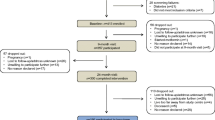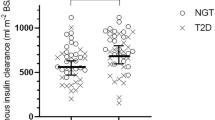Abstract
Aims
Decreased insulin clearance has been reported to be associated with insulin resistance-related disorders and incident type 2 diabetes. The aim of this study was to evaluate whether higher levels of uric acid (UA), a known risk factor of type 2 diabetes, are associated with a reduced insulin clearance.
Methods
440 non-diabetic individuals were stratified in tertiles according to serum UA levels. Insulin clearance and skeletal muscle insulin sensitivity were assessed by euglycemic hyperinsulinemic clamp. Hepatic insulin resistance was estimated by the liver IR index.
Results
Subjects with higher levels of UA displayed an unfavorable metabolic phenotype with a worse lipid profile, increased levels of 2-h post-load glucose levels, fasting, and 2-h post-load insulin levels, hsCRP, liver IR index, and lower levels of eGFR and skeletal muscle insulin sensitivity, in comparison to individuals with lower UA levels. Moreover, subjects with higher UA concentrations exhibited decreased levels of insulin clearance even after adjustment for age, gender, BMI, eGFR, and skeletal muscle insulin sensitivity. In a multivariate regression analysis model including several confounding factors, UA concentration was an independent predictor of insulin clearance (β = − 0.145; P = 0.03). However, when liver IR index was included in the model, the independent association between UA levels and insulin clearance was not retained. Accordingly, in a mediation analysis, liver IR index was a mediator of the negative effects of UA levels on insulin clearance (t = − 2.55, P = 0.01).
Conclusions
Higher serum levels of UA may affect insulin clearance by impairing hepatic insulin sensitivity.

Similar content being viewed by others
References
Duckworth WC, Bennett RG, Hamel FG (1998) Insulin degradation: progress and potential. Endocr Rev 19:608–624
Hribal ML, D’Alfonso R, Giovannone B et al (2001) The sulfonylurea glimepiride regulates intracellular routing of the insulin-receptor complexes through their interaction with specific protein kinase C isoforms. Mol Pharmacol 59:322–330
Zhao L, Teter B, Morihara T et al (2004) Insulin-degrading enzyme as a downstream target of insulin receptor signaling cascade: implications for Alzheimer’s disease intervention. J Neurosci 24:11120–11126
Seta KA, Roth RA (1997) Overexpression of insulin degrading enzyme: cellular localization and effects on insulin signaling. Biochem Biophys Res Commun 231:167–171
Bonora E, Zavaroni I, Coscelli C, Butturini U (1983) Decreased hepatic insulin extraction in subjects with mild glucose intolerance. Metabolism 32:438–446
Sesti G, D’Alfonso R, Vargas Punti MD et al (1996) Delayed intracellular dissociation of the insulin-receptor complex impairs receptor recycling and insulin processing in cultured EBV-transformed lymphocytes from insulin-resistant subjects. Diabetologia 39:289–297
Kotronen A, Juurinen L, Tiikkainen M, Vehkavaara S, Yki-Järvinen H (2008) Increased liver fat, impaired insulin clearance, and hepatic and adipose tissue insulin resistance in type 2 diabetes. Gastroenterology 135:122–130
Kotronen A, Vehkavaara S, Seppälä-Lindroos A, Bergholm R, Yki-Järvinen H (2007) Effect of liver fat on insulin clearance. Am J Physiol Endocrinol Metab 293:E1709–E1715
Pivovarova O, Bernigau W, Bobbert T et al (2013) Hepatic insulin clearance is closely related to metabolic syndrome components. Diabetes Care 36:3779–3785
Marini MA, Frontoni S, Succurro E et al (2013) Decreased insulin clearance in individuals with elevated 1-h post-load plasma glucose levels. PLoS One 8:e77440
Marini MA, Frontoni S, Succurro E et al (2014) Differences in insulin clearance between metabolically healthy and unhealthy obese subjects. Acta Diabetol 51:257–261
Marini MA, Frontoni S, Succurro E et al (2013) Insulin clearance is associated with carotid artery intima-media thickness. Atherosclerosis 229(2):453–458
Farris W, Mansourian S, Chang Y et al (2003) Insulin-degrading enzyme regulates the levels of insulin, amyloid beta-protein, and the beta-amyloid precursor protein intracellular domain in vivo. Proc Natl Acad Sci USA 100:4162–4167
Abdul-Hay SO, Kang D, McBride M, Li L, Zhao J, Leissring MA (2011) Deletion of insulin-degrading enzyme elicits antipodal, age-dependent effects on glucose and insulin tolerance. PLoS One 6:e20818
Lee CC, Haffner SM, Wagenknecht LE et al (2013) Insulin clearance and the incidence of type 2 diabetes in Hispanics and African Americans: the IRAS Family Study. Diabetes Care 36:901–907
Perticone F, Sciacqua A, Perticone M et al (2012) Serum uric acid and 1-h postload glucose in essential hypertension. Diabetes Care 35:153–157
Meshkani R, Zargari M, Larijani B (2011) The relationship between uric acid and metabolic syndrome in normal glucose tolerance and normal fasting glucose subjects. Acta Diabetol 48:79–88
Li Y, Xu C, Yu C, Xu L, Miao M (2009) Association of serum uric acid level with non-alcoholic fatty liver disease: a cross-sectional study. J Hepatol 50:1029–1034
Bonora E, Targher G, Zenere MB et al (1996) Relationship of uric acid concentration to cardiovascular risk factors in young men. Role of obesity and central fat distribution. The Verona Young Men Atherosclerosis Risk Factors Study. Int J Obes Relat Metab Disord 20:975–980
Perticone F, Maio R, Tassone JE et al (2013) Interaction between uric acid and endothelial dysfunction predicts new onset of diabetes in hypertensive patients. Int J Cardiol 167:232–236
Dehghan A, van Hoek M, Sijbrands EJ, Hofman A, Witteman JC (2008) High serum uric acid as a novel risk factor for type 2 diabetes. Diabetes Care 31:361–362
Krishnan E, Pandya BJ, Chung L, Hariri A, Dabbous O (2012) Hyperuricemia in young adults and risk of insulin resistance, prediabetes, and diabetes: a 15-year follow-up study. Am J Epidemiol 176(2):108–116
Hayashino Y, Okamura S, Tsujii S, Ishii H (2016) Association of serum uric acid levels with the risk of development or progression of albuminuria among Japanese patients with type 2 diabetes: a prospective cohort study. Acta Diabetol 53:599–607
Verdecchia P, Schillaci G, Reboldi G, Santeusanio F, Porcellati C, Brunetti P (2000) Relation between serum uric acid and risk of cardiovascular disease in essential hypertension. The PIUMA study. Hypertension 36(6):1072–1078
Niskanen LK, Laaksonen DE, Nyyssönen K et al (2004) Uric acid level as a risk factor for cardiovascular and all-cause mortality in middle-aged men: a prospective cohort study. Arch Intern Med 164:1546–1551
Perticone M, Tripepi G, Maio R et al (2017) Risk reclassification ability of uric acid for cardiovascular outcomes in essential hypertension. Int J Cardiol 243:473–478
Sesti G, Hribal ML, Procopio T et al (2014) Low circulating insulin-like growth factor-1 levels are associated with high serum uric acid in nondiabetic adult subjects. Nutr Metab Cardiovasc Dis 24:1365–1372
Spiga R, Marini MA, Mancuso E et al (2017) Uric acid is associated with inflammatory biomarkers and induces inflammation via activating the NF-κB signaling pathway in HepG2 cells. Arterioscler Thromb Vasc Biol 37:1241–1249
Zhu Y, Hu Y, Huang T et al (2014) High uric acid directly inhibits insulin signalling and induces insulin resistance. Biochem Biophys Res Commun 447:707–714
Wan X, Xu C, Lin Y et al (2016) Uric acid regulates hepatic steatosis and insulin resistance through the NLRP3 inflammasome-dependent mechanism. J Hepatol 64:925–932
Marini MA, Fiorentino TV, Andreozzi F et al (2017) Elevated 1-h post-challenge plasma glucose levels in subjects with normal glucose tolerance or impaired glucose tolerance are associated with whole blood viscosity. Acta Diabetol 54:775–784
Vangipurapu J, Stančáková A, Kuulasmaa T et al (2011) A novel surrogate index for hepatic insulin resistance. Diabetologia 54:540–543
Baron RM, Kenny DA (1986) The moderator-mediator variable distinction in social psychological research: conceptual, strategic, and statistical considerations. J Pers Soc Psychol 51:1173–1182
Lee CC, Lorenzo C, Haffner SM et al (2013) The association of inflammatory and fibrinolytic proteins with 5 year change in insulin clearance: the Insulin Resistance Atherosclerosis Study (IRAS). Diabetologia 56:112–120
Tassone EJ, Cimellaro A, Perticone M et al (2018) Uric acid impairs insulin signaling by promoting Enpp1 binding to insulin receptor in human umbilical vein endothelial cells. Front Endocrinol. https://doi.org/10.3389/fendo.2018.00098 (Epub ahead of print)
Hulse RE, Ralat LA, Wei-Jen T (2009) Structure, function, and regulation of insulin-degrading enzyme. Vitam Horm 80:635–648
Hamel FG, Upward JL, Bennett RG (2003) In vitro inhibition of insulin-degrading enzyme by long-chain fatty acids and their coenzyme A thioesters. Endocrinology 144:2404–2408
Ralat LA, Ren M, Schilling AB, Tang WJ (2009) Protective role of Cys-178 against the inactivation and oligomerization of human insulin-degrading enzyme by oxidation and nitrosylation. J Biol Chem 284:34005–34018
Sautin YY, Nakagawa T, Zharikov S, Johnson RJ (2007) Adverse effects of the classic antioxidant uric acid in adipocytes: NADPH oxidase-mediated oxidative/nitrosative stress. Am J Physiol Cell Physiol 293:C584–C596
Sesti G, Fiorentino TV, Hribal ML, Sciacqua A, Perticone F (2013) Association of hepatic insulin resistance indexes to nonalcoholic fatty liver disease and related biomarkers. Nutr Metab Cardiovasc Dis 23:1182–1187
Bonora E, Capaldo B, Perin PC et al (2008) Hyperinsulinemia and insulin resistance are independently associated with plasma lipids, uric acid and blood pressure in non-diabetic subjects. The GISIR database. Nutr Metab Cardiovasc Dis 18:624–631
Facchini F, Chen YD, Hollenbeck CB, Reaven GM (1991) Relationship between resistance to insulin-mediated glucose uptake, urinary uric acid clearance, and plasma uric acid concentration. JAMA 266:3008–3011
Arcaro G, Cretti A, Balzano S et al (2002) Insulin causes endothelial dysfunction in humans: sites and mechanisms. Circulation 105:576–582
Madonna R, Pandolfi A, Massaro M, Consoli A, De Caterina R (2004) Insulin enhances vascular cell adhesion molecule-1 expression in human cultured endothelial cells through a pro-atherogenic pathway mediated by p38 mitogen-activated protein-kinase. Diabetologia 47:532–536
Okouchi M, Okayama N, Imai S et al (2002) High insulin enhances neutrophil transendothelial migration through increasing surface expression of platelet endothelial cell adhesion molecule-1 via activation of mitogen activated protein kinase. Diabetologia 45:1449–1456
Author information
Authors and Affiliations
Contributions
T.V.F. researched and analyzed data, and wrote and edited the manuscript; E.S, E.P, F.A, and A.S. researched data and reviewed the manuscript; M.L.H. and F.P. contributed to the discussion and reviewed the manuscript; G.S. designed the study, contributed to analyze the data, and reviewed the manuscript. All authors have read and approved the final manuscript.
Corresponding author
Ethics declarations
Conflict of interest
The authors declare that they have no conflict of interest.
Human and animal rights
All procedures followed were in accordance with the ethical standards of the responsible committee on human experimentation (Comitato Etico Azienda Ospedaliera “Mater Domini”, Italy) and with the Helsinki Declaration of 1975.
Informed consent
Informed consent was obtained from all patients for being included in the study.
Additional information
Managed by Antonio Secchi.
Electronic supplementary material
Below is the link to the electronic supplementary material.
Rights and permissions
About this article
Cite this article
Fiorentino, T.V., Sesti, F., Succurro, E. et al. Higher serum levels of uric acid are associated with a reduced insulin clearance in non-diabetic individuals. Acta Diabetol 55, 835–842 (2018). https://doi.org/10.1007/s00592-018-1153-8
Received:
Accepted:
Published:
Issue Date:
DOI: https://doi.org/10.1007/s00592-018-1153-8




